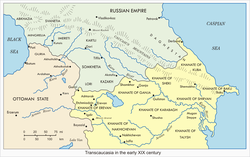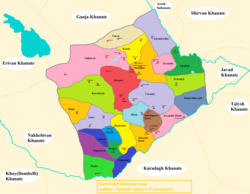
Back خانية قره باغ Arabic Qarabağ xanlığı Azerbaijani قاراباغ خانلیغی AZB Ҡарабах ханлығы Bashkir Карабахскае ханства Byelorussian কারাবাখ খানাত Bengali/Bangla Kanat de Karabagh Catalan Karabašský chanát Czech Карабах ханлăхĕ CV Khanat Karabach German
| Kanato de Karabaj Qarabağ xanlığı خانات قرهباغ | |||||||||||||||||||||||||||||||||
|---|---|---|---|---|---|---|---|---|---|---|---|---|---|---|---|---|---|---|---|---|---|---|---|---|---|---|---|---|---|---|---|---|---|
| Kanato bajo suzeranía iraní[1] | |||||||||||||||||||||||||||||||||
| 1748-1822 | |||||||||||||||||||||||||||||||||
 Los kanatos de Transcaucasia a principios del siglo XIX. | |||||||||||||||||||||||||||||||||
 Melikates del kanato de Karabaj | |||||||||||||||||||||||||||||||||
| Coordenadas | 39°45′30″N 46°44′54″E / 39.758333333333, 46.748333333333 | ||||||||||||||||||||||||||||||||
| Capital |
Bayat (1748-1752) Susa (1752-1822) | ||||||||||||||||||||||||||||||||
| Entidad | Kanato bajo suzeranía iraní[1] | ||||||||||||||||||||||||||||||||
| Idioma oficial | Persa (oficial)[2][3] | ||||||||||||||||||||||||||||||||
| • Otros idiomas | Azerí, armenio, afshar | ||||||||||||||||||||||||||||||||
| Superficie | |||||||||||||||||||||||||||||||||
| • Total | 17 000 km² | ||||||||||||||||||||||||||||||||
| Historia | |||||||||||||||||||||||||||||||||
| • 1748 | Independencia | ||||||||||||||||||||||||||||||||
| • 1822 | Anexión al Imperio ruso | ||||||||||||||||||||||||||||||||
| |||||||||||||||||||||||||||||||||
El kanato de Karabaj fue un estado constituido en el oriente de la Armenia bajo la soberanía iraní. Después de haber sido ocupada varias veces por el Imperio otomano y luego reconquistada por los safávidas, fue brevemente el centro de un pequeño estado armenio antes de independizarse en 1748 bajo la dinastía local Javanshir. Fue incorporado como estado vasallo en el Imperio ruso después del tratado de Gulistán antes de ser anexado en 1822.
- ↑ Bournoutian, George A. (2016). The 1820 Russian Survey of the Khanate of Shirvan: A Primary Source on the Demography and Economy of an Iranian Province prior to its Annexation by Russia. Gibb Memorial Trust. p. xvii. ISBN 978-1909724808. «Serious historians and geographers agree that after the fall of the Safavids, and especially from the mid-eighteenth century, the territory of the South Caucasus was composed of the khanates of Ganja, Kuba, Shirvan, Baku, Talesh, Sheki, Karabagh, Nakhichivan and Yerevan, all of which were under Iranian suzerainty.»
- ↑ Swietochowski, Tadeusz (2004). Russian Azerbaijan, 1905-1920: The Shaping of a National Identity in a Muslim Community. Cambridge: Cambridge University Press. p. 12. ISBN 978-0521522458. «(...) and Persian continued to be the official language of the judiciary and the local administration [even after the abolishment of the khanates].»
- ↑ Pavlovich, Petrushevsky Ilya (1949). Essays on the history of feudal relations in Armenia and Azerbaijan in XVI - the beginning of XIX centuries. LSU them. Zhdanov. p. 7. «(...) The language of official acts not only in Iran proper and its fully dependant Khanates, but also in those Caucasian khanates that were semi-independent until the time of their accession to the Russian Empire, and even for some time after, was New Persian (Farsi). It played the role of the literary language of class feudal lords as well.»